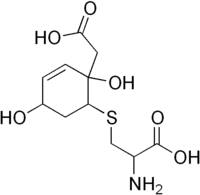Hawkinsinuria
| Hawkinsinuria | |
|---|---|
| Classification and external resources | |
 | |
| ICD-10 | E72.1 |
| OMIM | 140350 |
| DiseasesDB | 29836 |
| MeSH | D020176 |
Hawkinsinuria, also called 4-Alpha-hydroxyphenylpyruvate hydroxylase deficiency, is an autosomal dominant metabolic disorder affecting the metabolism of tyrosine.[1] Normally, the breakdown of the amino acid tyrosine involves the conversion of 4-hydroxyphenylpyruvate to homogentisate by 4-Hydroxyphenylpyruvate dioxygenase. Complete deficiency of this enzyme would lead to tyrosinemia III. In rare cases, however, the enzyme is still able to produce the reactive intermediate 1,2-epoxyphenyl acetic acid, but is unable to convert this intermediate to homogentisate. The intermediate then spontaneously reacts with glutathione to form 2-L-cystein-S-yl-1,4-dihydroxy-cyclohex-5-en-1-yl acetic acid (hawkinsin).
Patients present with metabolic acidosis during the first year of life, which should be treated by a phenylalanine- and tyrosine-restricted diet. The tolerance toward these amino acids normalizes as the patients get older. Then only a chlorine-like smell of the urine indicates the presence of the condition, patients have a normal life and do not require treatment or a special diet.
The production of hawkinsin is the result of a gain-of-function mutation, inheritance of hawkinsinuria is therefore autosomal dominant (presence of a single mutated copy of the gene causes the condition). Most other inborn errors of metabolism are caused by loss-of-function mutations, and hence have recessive inheritance (condition occurs only if both copies are mutated).

See also
References
- ↑ Tomoeda K, Awata H, Matsuura T, Matsuda I, Ploechl E, Milovac T, Boneh A, Scott CR, Danks DM, Endo F (2000). "Mutations in the 4-hydroxyphenylpyruvic acid dioxygenase gene are responsible for tyrosinemia type III and hawkinsinuria". Mol Genet Metab. 71 (3): 506–510. doi:10.1006/mgme.2000.3085. PMID 11073718.
| |||||||||||||||||||||||||||||||||||||||||||||||||||||||||||||||||||||||||||||